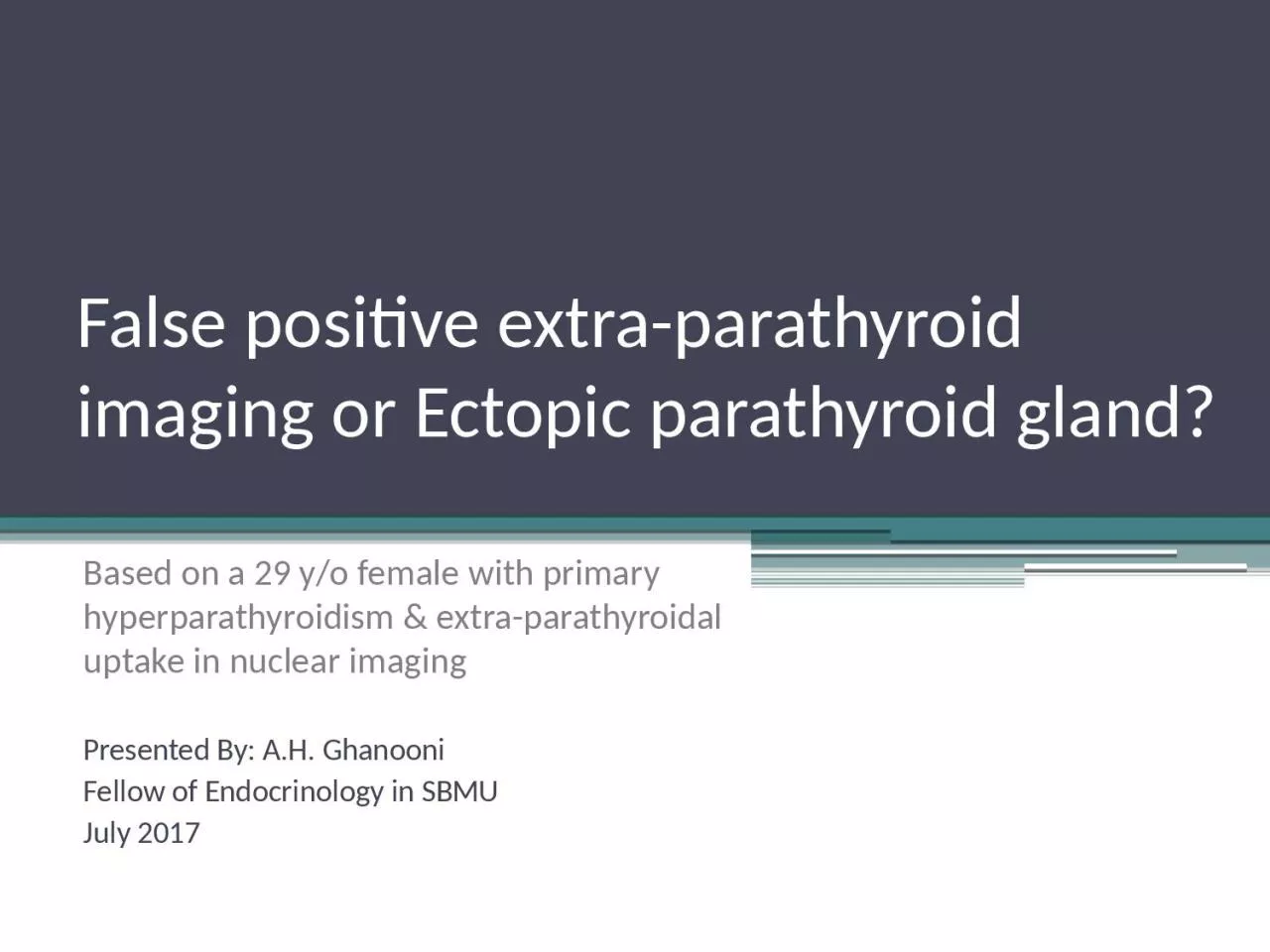

Based on a 29 yo female with primary hyperparathyroidism amp extra parathyroidal uptake in nuclear imaging Presented By AH Ghanooni Fellow of Endocrinology in SBMU July 2017 ANATOMY OF PARATHYROID GLANDS ID: 932318
Download Presentation The PPT/PDF document "False positive extra-parathyroid imaging..." is the property of its rightful owner. Permission is granted to download and print the materials on this web site for personal, non-commercial use only, and to display it on your personal computer provided you do not modify the materials and that you retain all copyright notices contained in the materials. By downloading content from our website, you accept the terms of this agreement.
Slide1
False positive extra-parathyroid imaging or Ectopic parathyroid gland?
Based on a 29 y/o female with primary hyperparathyroidism & extra-
parathyroidal
uptake in nuclear imaging
Presented By: A.H. Ghanooni
Fellow of Endocrinology in SBMU
July 2017
Slide2ANATOMY OF PARATHYROID GLANDS
There are normally two pairs of parathyroid glands, the upper and lower pairs, which are located close to the dorsal side of the thyroid gland.
Slide3Ectopic parathyroid gland
Approximately
6%
of normal individuals have one or more of the glands sited in ectopic positions, occasionally there may be more than four glands.
Ectopic glands can be found in a wide range of sites but most commonly are in the neck, thymus, carotid sheath and
mediastinum
.
Glands at any of these sites may become autonomous.
Up
to one in five
parathyroid glands may
be located
ectopically, and this is especially true of
supernumerary glands
.
(
williams
2017)
Slide4645
normal adult parathyroid glands in
160
cadavers
Slide5Slide6Slide7Slide8determine the incidence of abnormal ectopic
parathyroid
glands, their specific locations, and the accuracy
of preoperative localization using
technetium-99m–sestamibi
scintigraphy
.
Slide9Collected from
a parathyroid database and a retrospective chart
review of
consecutive patients operated on for hyperparathyroidism
from
1990 to
2005
.
Definition :
An ectopic inferior parathyroid gland
was defined as a gland in a location other than on or immediately adjacent to the anterior or
posteriolateral surface of the inferior pole of the thyroid gland.
An
ectopic superior parathyroid
gland
was
defined as a gland in a location other than
juxtacricothyroidal
posteriorly
or within the capsule of the
posterior surface
of the superior pole of the thyroid gland.
Slide10Results:
Of the 231 patients operated on for
hyperparathyroidism,
37
(16%)
had an abnormal ectopic
parathyroid gland.
Ectopic
parathyroid glands were superior in 14 (38%) and
inferior in 23 (62%) patients.
Slide11Results:Ectopic Superior
glands were found
in (14 patients) :
tracheoesophageal groove in 6 (43%),
Retroesophageal
in 3 (22%),
in the
posterosuperior
mediastinum in 2 (14%), intrathyroidal in 1 (7%), within the carotidsheath in 1 (7%),
and paraesophageal in 1 (7%) patient.Ectopic Inferior glands were found in (23 patients):thymus in 7 (30%),
The anterosuperior mediastinum in 5 (22%), intrathyroidal in 5 (22%), the thyrothymic ligament in 4 (17%),
and
undescended
in a
submandibular
location in 2 (9%) patients.
Slide12Slide13Slide14Slide15LOCALIZATION OF PARATHYROID GLAND
Techniques used include high-resolution ultrasound (US), computerized tomography (CT), magnetic resonance imaging (MRI), selective venous sampling and a variety of nuclear medicine techniques.
The use of high-resolution
ultrasonography
has reported
sensitivities between 43% and 92%
.
CT has a reported
sensitivity of 35-76%
but probably has its major use in examining the mediastinum. Venous sampling is a relatively invasive technique requiring a high degree of operator dependency and may be useful in persistent or recurrent disease.
MRI has a reported sensitivity of 50-93% and is still undergoing further evaluation. These techniques therefore have similar ranges of sensitivity of detection, and this is partly determined by the size of the lesion.
Slide16RADIONUCLIDE TECHNIQUES
99mTc-hexakis-2-methoxyisobutyl-isonitrile (99mTc-sestamibi) imaging is now the technique of choice for parathyroid localization.
The difference in retention may be explained by the increased number of mitochondria in the cells of an adenoma and the fact that 99mTc-sestamibi is sequestered in the mitochondria.
Slide17FALSE-POSITIVE SCANS
the most common cause of false-positive scans is
solid thyroid nodules
.
Other false-positive images have been described with
sarcoidosis
,
thyroid carcinoma
,
lymphoma, and other tumors.
Sestamibi may also be seen to accumulate in brown tumors as well as parathyroid metastases.
Slide18A prospective database of 3,187
patients who underwent
neck exploration for
PHPT was
reviewed
to identify
patients who had
concurrent
thyroid
resection.Patients with benign and malignant thyroid disease were comparatively analyzed.
Slide19Results
:
A total of
470 patients underwent both thyroidectomy
and
parathyroidectomy
Dual-isotope
scintigraphy
obtained in 374 patients (80%) had a sensitivity of 67% and a positive predictive value of 66%
for parathyroid adenoma localization in these patients with thyroid disease. False-positive scintigraphy occurred
in 22% with benign
and
45% with malignant thyroid
disease
(P
= 0.002).
Slide20Slide21Slide22Slide23Key message
A
Tc
-MIBI-Hot/I-123-Cold phenotype is very specific for detecting thyroid malignancy.
Patients with
this
imaging
phenotype should strongly be
considered for
preoperative ultrasound-guided biopsy. Patients found intraoperatively to have false-positive parathyroid scintigraphy
should be evaluated for thyroid cancer.
Slide24HPT-JT (HPT- Jaw Tumor Syndrome)
HPT-JT is a syndrome of
HPT
, jaw tumors, and
renal lesions.
Transmission is
autosomal
dominant.
The most common and sometimes the only feature is HPT.
The HPT typically involves one parathyroid gland at a time, and there is a uniquely
high malignant potential in the parathyroid tumor; 15%
of patients have
parathyroid cancer.
Slide25HPT-JT (HPT- Jaw Tumor Syndrome)
The associated jaw tumors (
in 25
%) are ossifying or cementifying
fibromas
.
Unlike the jaw
tumors of HPT, they
are not
osteoclast-rich or influenced by the parathyroid status
.The associated renal lesions (in 5%) are multiple renal cysts, hamartomas
, or Wilms tumor.Uterine tumors are common and can impair
fertility.